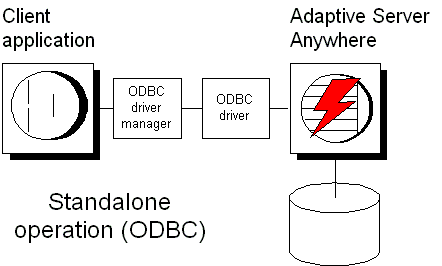 New Features and Upgrading Guide
New Features and Upgrading Guide
 CHAPTER 3. New Features in Adaptive Server Anywhere 6.0
CHAPTER 3. New Features in Adaptive Server Anywhere 6.0
This section describes new features for the Adaptive Server Anywhere programming interfaces, and new interfaces supported.
 New ODBC features
New ODBC featuresThere are two major areas of change to the ODBC support for Adaptive Server Anywhere Version 6:
Native ODBC The ODBC driver is now a native interface to Adaptive Server Anywhere. A native interface is one that does not require translation to some other interface before commands are sent to the database server.
ODBC 3.0 support Version 3.0 of the ODBC programming interface was introduced during 1997. Adaptive Server Anywhere Version 6 supports ODBC 3.0.
 Native ODBC
Native ODBCIn previous releases of SQL Anywhere (as in other DBMS's), ODBC was a non-native interface. An ODBC driver translated ODBC calls to a set of "native" calls, which were passed on to the native interface DLL.

In Adaptive Server Anywhere the ODBC driver sends commands directly to the database server, with no intervening "native" library.

SQL Anywhere Version 5 provided a native interface using Embedded SQL. This library is still a native interface to Adaptive Server Anywhere:

 ODBC 3.0 support
ODBC 3.0 supportAdaptive Server Anywhere Version 6 provides support for ODBC 3.0.
ODBC features are arranged according to a level of conformance. Features are either Core, Level 1, or Level 2, with level 2 being the most complete level of ODBC support. These features are listed in the ODBC Programmer's Reference, which is available from Microsoft Corporation as part of the ODBC software development kit or from the following location on the Microsoft Web site:
.
Adaptive Server Anywhere ODBC 3.0 support is as follows:
Core conformance Adaptive Server Anywhere supports all Core level features.
Level 1 conformance Adaptive Server Anywhere supports all Level 1 features, except for asynchronous execution of ODBC functions.
Level 2 conformance Adaptive Server Anywhere supports all Level 2 features, except for the following:
Three part names of tables and views. This is not applicable for Adaptive Server Anywhere.
Asynchronous execution of ODBC functions for specified individual statements.
Ability to time out login request and SQL queries.
While you can use new ODBC 3.0 features, such as descriptors, in your ODBC applications, ODBC 2.x applications will continue to work with Adaptive Server Anywhere and the ODBC 3.0 driver manager.
The ODBC driver manager is part of the ODBC software supplied with Adaptive Server Anywhere. The ODBC 3.0 driver manager has a new interface for configuring ODBC data sources.
 JDBC, Open Client, and TDS support
JDBC, Open Client, and TDS supportAdaptive Server Anywhere can appear to client applications as an Open Server. That is, it provides native support for the Sybase Open Client programming interface, and therefore native support for Sybase applications such as Replication Server and OmniConnect.
SQL Anywhere Version 5 provided support for Open Client applications using the separate Open Server Gateway executable. This executable enabled SQL Anywhere to appear as an Open Server to Open Client applications.
There is no Open Server Gateway in Adaptive Server Anywhere Version 6. Instead, the Adaptive Server Anywhere database server can be set up to act as an Open Server itself. This change simplifies setup, improves performance, improves compatibility, and cuts down dramatically on the memory and disk resources required to provide Open Client access to your databases.
The application protocol used to send and receive requests between clients and servers in Open Client/Open Server is called the Tabular Data Stream (TDS). To say that Adaptive Server Anywhere can appear as an Open Server means that it now provides support for client applications using TDS.
The Sybase jConnect JDBC driver uses TDS, even though it does not require the Open Client libraries. Adaptive Server Anywhere supports JDBC connections using Sybase jConnect.
 For a full description of Open Client support, see Adaptive Server Anywhere as an Open Server.
For a full description of Open Client support, see Adaptive Server Anywhere as an Open Server.
 For a full description of JDBC support, see your Sybase jConnect documentation and Data Access Using JDBC.
For a full description of JDBC support, see your Sybase jConnect documentation and Data Access Using JDBC.
 Embedded SQL features
Embedded SQL featuresDESCRIBE enhancements The DESCRIBE statement can now describe user-defined data types. On a normal DESCRIBE, the indicator variable is set to DT_HAS_USERTYPE_INFO if a column of the result set has a user-defined data type. In such a case, you can use DESCRIBE USER TYPES to obtain information about the user-defined data type.
 For information, see DESCRIBE statement, and The SQL descriptor area (SQLDA).
For information, see DESCRIBE statement, and The SQL descriptor area (SQLDA).
Use of ODBC data sources Embedded SQL applications can now take advantage of ODBC data sources to store connection information.
